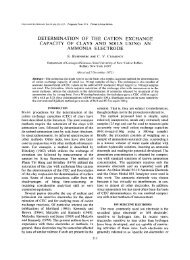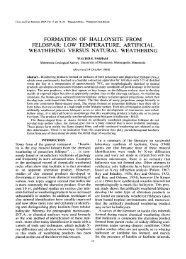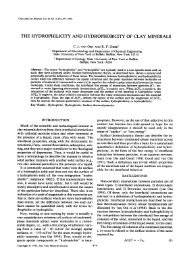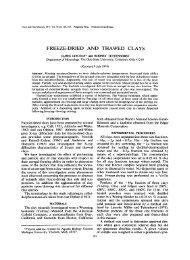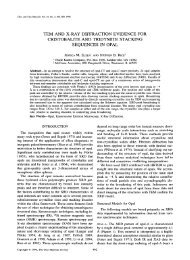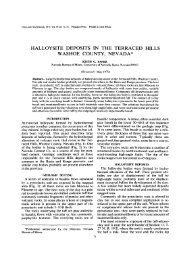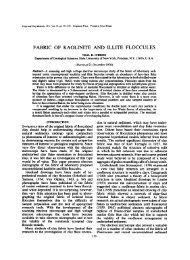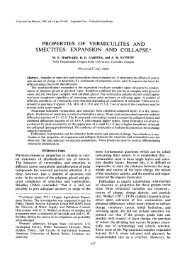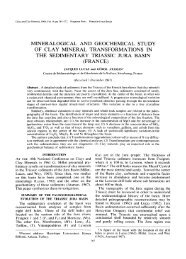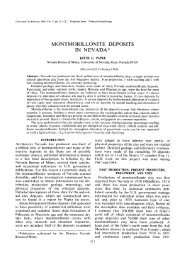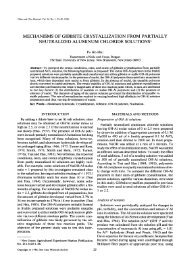physicochemical properties of montmorillonite interlayered
physicochemical properties of montmorillonite interlayered
physicochemical properties of montmorillonite interlayered
Create successful ePaper yourself
Turn your PDF publications into a flip-book with our unique Google optimized e-Paper software.
Clays and Clay Minerals, Vol. 31, No. 1, 22-28, 1983.<br />
PHYSICOCHEMICAL PROPERTIES OF MONTMORILLONITE<br />
INTERLAYERED WITH CATIONIC OXYALUMINUM PILLARS<br />
M. L. OCCELLI AND R. M. TINDWA<br />
Gulf Research & Development Company, P.O. Drawer 2038<br />
Pittsburgh, Pennsylvania 15230<br />
Abstract--By ion exchanging expandable clay minerals with large, cationic oxyaluminum polymers, "pillars"<br />
were introduced that permanently prop open the clay layers. On the basis <strong>of</strong> thermal, infrared spectroscopic,<br />
adsorption, and X-ray powder diffraction (XRD) analysis, the interlayering <strong>of</strong> commercial sodium<br />
bentonite with aluminum chlorohydroxide, lAI1304(OH)24(HzO)12] +7, polymers appears to have produced<br />
an expanded clay with a surface area <strong>of</strong> 200-300 m2/g. The pillared product contained both Br6nsted and<br />
Lewis acid sites. XRD and differential scanning calorimetry measurements indicated that the micropore<br />
structure <strong>of</strong> this <strong>interlayered</strong> clay is stable to 540~ Between 540 ~ and 760~ the pillared day collapsed<br />
with a corresponding decrease in surface area (to 55 m2/g) and catalytic cracking activity for a Kuwait gas<br />
oil having a 260~176 boiling range.<br />
Key Words--Catalysis, Interlayering, Molecular sieve, Montmorillonite, Oxyaluminum, Pillar.<br />
INTRODUCTION<br />
Since their introduction in the early 1950s, molecular<br />
sieves have developed into an estimated $250,000,000<br />
business providing catalysts and adsorbents for the<br />
chemical and petrochemical industry (Flanigen, 1980),<br />
During the past 25 years, more than 100 species <strong>of</strong> zeo-<br />
lites have been synthesized, yet only a few (e.g., types<br />
A, X, Y, ZSM-5, mordenite, erionite) have found a sig-<br />
nificant industrial application (Breck, 1980). Among<br />
these, NaY alone represents more than 95% <strong>of</strong> the total<br />
worldwide zeolite usage. The open, three-dimensional<br />
framework structure, the large pore size (-8.0 Jk), and<br />
the high thermal and hydrothermal stability <strong>of</strong> zeolites<br />
with the faujasite structure contribute significantly to<br />
the wide use <strong>of</strong> these materials in the preparation <strong>of</strong><br />
petroleum cracking catalysts. The limited range <strong>of</strong> pore<br />
size (2 to 8/~), however, limits the utility <strong>of</strong> zeolites as<br />
catalysts for the conversion <strong>of</strong> high molecular weight<br />
hydrocarbons <strong>of</strong> the type found in synthetic and heavy<br />
oils.<br />
A new class <strong>of</strong> molecular sieve-like materials with a<br />
pore-size range (6 to 40 A) larger than faujasite-type<br />
zeolites has been synthesized by interlayering expand-<br />
able clay minerals with large cations. Loeppert et al.<br />
(1979) prepared expanded smectites using bipyridyl and<br />
1,10-phenanthroline complexes stable to 550~ Burrer<br />
(1978) reviewed the interlayering <strong>of</strong> smectites with polar<br />
organic molecules. Highly stable, high surface-area<br />
material can best be prepared by crosslinking layers <strong>of</strong><br />
expanding layered silicates with oligomeric molecules<br />
derived from the hydrolysis <strong>of</strong> polyvalent cations, such<br />
as AI +3 and Zr +4 (Yamanaka and Brindley, 1979; Brind-<br />
ley and Sempels, 1977; Lahav et al., 1978; Shabtai et<br />
al., 1980).<br />
Copyright 9 1983, The Clay Minerals Society 22<br />
Vaughan and Lussier (1980) showed that the inter-<br />
layering <strong>of</strong> <strong>montmorillonite</strong> with hydroxy-aluminum<br />
oligomers generates materials that can be used in con-<br />
ventional petrochemical processes, such as catalytic<br />
cracking and hydrocracking. On the basis <strong>of</strong> their sorp-<br />
tive <strong>properties</strong>, these <strong>interlayered</strong> <strong>montmorillonite</strong>s ap-<br />
pear to behave like two-dimensional molecular sieves,<br />
sorbing 1,3,5-trimethylbenzene (kinetic diame-<br />
ter = 7.6/~) but not perfluorobutylamine (10.4 A). The<br />
present paper further explores the relationship between<br />
zeolites and <strong>interlayered</strong> clays, and reports on the cor-<br />
relation that exists between the chemical and physical<br />
<strong>properties</strong> <strong>of</strong> an <strong>interlayered</strong> clay and its catalytic ac-<br />
tivity.<br />
Montmorillonite<br />
EXPERIMENTAL<br />
The bentonite used is a crushed rock containing/>90%<br />
Na-<strong>montmorillonite</strong> and minor amounts <strong>of</strong> feldspar,<br />
biotite, and gypsum impurities and was obtained from<br />
the American Colloid Company (Volclay Yellow-Tan<br />
Grade, 325 mesh). This type <strong>of</strong> Na-bentonite was stud-<br />
ied by Yamanaka and Brindley (1979) and Vaughan and<br />
Lussier (1980). The chemical composition (Table 1)<br />
provided by the supplier is typical <strong>of</strong> this material.<br />
Infrared, X-ray powder diffraction,<br />
and thermal analysis<br />
Infrared (IR) spectra were obtained using a Nicolet<br />
7000 FT-IR spectrometer, Samples were pressed at 1500<br />
atm into self-supporting wafers approximately one inch<br />
in diameter. The wafers were then mounted in an op-<br />
tical cell, evacuated at -0.01 torr, and degassed by
Vol. 31, No. 1, 1983 Montmorilionite <strong>interlayered</strong> with oxyaluminum pillars 23<br />
Table 1. Typical chemical analysis <strong>of</strong> Upton (Wyoming) Na-<br />
bentonite (Volclay, Yellow-Tan Grade).<br />
Wt. %z<br />
SiO3 63.02<br />
Al~O3 21.08<br />
Fe203 3.25<br />
FeO 0.35<br />
MgO 2.67<br />
Na20 + K20 2.57<br />
CaO 0.67<br />
H~O 5.64<br />
Trace elements 0.72<br />
Provided by the American Colloidal Company.<br />
2 Moisture free.<br />
heating for 3 hr at 400~ After cooling the wafers to<br />
room temperature, pyridine was adsorbed in the sam-<br />
ples. X-ray powder diffraction (XRD) measurements<br />
were obtained using a Picker X-ray diffractometer at a<br />
scan rate <strong>of</strong> l~ and monochromatic CuK~ radia-<br />
tion. Differential scanning calorimetry (DSC) measure-<br />
ments and thermal gravimetric analyses (TGA) were<br />
obtained with a DuPont 1090 thermogravimetric ana-<br />
lyzer using nitrogen as a purge gas and heating rates <strong>of</strong><br />
20~ and 5~ respectively.<br />
Interlayering cation<br />
Dissolved AI +z readily hydrates in water to<br />
AI(H20)6 +3. The high charge on the A1 § ion weakens<br />
the O-H bond <strong>of</strong> the coordinated water, allowing<br />
proton dissociation to occur with ease (Bailar, 1956).<br />
Upon losing one H § a 1/3 basic aluminum cation<br />
dimer [A12(OH)2(H20)s] +4 is obtained. 1 As the pH<br />
is increased, the dimers condense to form chain<br />
structures until a stable 2/3 basic aluminum salt<br />
[A16(OH)12(H20)~] +6 is formed (Treadwell and Lien,<br />
1931; Hsu and Bates, 1964). As the basicity <strong>of</strong> the so-<br />
lution is increased further, these six-member ring oligo-<br />
mers coalesce producing a stable 5/6 basic aluminum<br />
cation, such as [(A128(OH)70(H20)2s] +14 (Denk and Alt,<br />
1952; Hem and Roberson, 1967). In the present ex-<br />
periments, a 5/6 basic aluminum chloride (ACH) salt<br />
marketed by Reheis Chemical Company under the<br />
tradename <strong>of</strong> Chlorhydrol | was used (see Table 2). The<br />
structure <strong>of</strong> this salt has not been completely deter-<br />
mined, however, Johansson (1960) proposed that<br />
[AIt304(OH)24(H20)12] +7 is present, a cation that con-<br />
sists <strong>of</strong> a four-coordinated aluminum ion surrounded by<br />
12 A104-0ctahedra joined together by common edges.<br />
Interlayered <strong>montmorillonite</strong><br />
Sodium <strong>montmorillonite</strong> was ion exchanged with hy-<br />
droxy aluminum oligomers by first slurrying the clay in<br />
i The nomenclature <strong>of</strong> the basic aluminum cations is ex-<br />
plained in Denk and Alt (1952).<br />
Table 2. Chlorhydrol | 50% solution?<br />
Sample results<br />
A1203 23,4%<br />
C1 8.19%<br />
AI:C1 atomic ratio 1.98:1.0<br />
Sulfate (SO4)
24 Occelli and Tindwa Clays and Clay Minerals<br />
5<br />
"1> 3<br />
=1. o<br />
2<br />
I I I I I I<br />
.04 .08 .12 .16 .20 .24<br />
Figure 1. Nitrogen sorption representation using Langmuir<br />
(P/PoV vs. P/P0) and BET (P/(P0 - P)V vs. P/P0) isotherms.<br />
Prior to testing, the <strong>interlayered</strong> bentonite was heated over-<br />
night at 260~<br />
additional 0.03 g H20/g clay was lost. There was no<br />
weight change above 700~<br />
By comparison, the Na-bentonite used has a pore<br />
volume <strong>of</strong> -0.08 cm3/g and a cumulative loss <strong>of</strong> 0.14 g<br />
HzO/g clay. As can be seen in Figure 3, only 0.014 g<br />
H20/g <strong>of</strong> Na-bentonite was lost between 150 ~ and 500~<br />
Because the pillars did not dehydroxylate over this<br />
temperature range, an ACH-bentonite structure with a<br />
surface area <strong>of</strong> 280 m2/g must contain -0.053 g <strong>of</strong>" zeo-<br />
litic" water per gram <strong>of</strong> <strong>interlayered</strong> clay. The variation<br />
in surface area as a function <strong>of</strong> the activation temper-<br />
ature has been plotted on the same graph. Note the range<br />
<strong>of</strong> stability up to 540~ Above 540~ the pillars began<br />
to decompose, and the surface area shows a strong de-<br />
pendence on temperature. At 750~ the surface area<br />
was reduced to its original value prior to interlayering.<br />
The DSC curve (Figure 4) shows that an endothermic<br />
reaction took place between 100 ~ and 500~ corre-<br />
sponding to water loss from the clay surface and inter-<br />
layered space. At 500~ a second endotherm is present<br />
corresponding to the beginning <strong>of</strong> the collapse <strong>of</strong> the<br />
<strong>interlayered</strong> structure.<br />
These results are in agreement with published data<br />
on clays pillared with inorganic oxides. In fact, Ya-<br />
manaka and Brindley (1979) reported that by ex-<br />
change reactions with tetrameric hydroxy cations,<br />
[(Zr4(OH)14" nH20)] +2, Na-<strong>montmorillonite</strong>s with sur-<br />
face areas as high as 300-400 mZ/g, stable to 500~ can<br />
be obtained. Similarly, Vaughan et al. (1979) noted that<br />
P/Po<br />
760~<br />
650oc<br />
540~<br />
705~<br />
43 ~ 35 ~ 27 ~ 19 ~ 11 ~ 3 ~<br />
20 (COPPER RADIATION)<br />
Figure 2. X-ray powder diffraction patterns <strong>of</strong> ACH-benton-<br />
ite samples heat-treated for 4 hr at different temperatures.<br />
by interlayering unbeneficiated Na-bentonite with<br />
chlorohydroxide polymers, clays with surface areas <strong>of</strong><br />
250-350 mZ/g and basal spacings between 17.0 and 18.8<br />
A can be formed.<br />
Surface acidity<br />
Spectroscopic studies <strong>of</strong> adsorbed bases are well es-<br />
tablished and are useful techniques for investigating the<br />
surface acidity <strong>of</strong> heterogeneous catalysts (Svoboda and<br />
Kunze, 1966). Parry (1963) showed that specific ad-<br />
sorption bands in the vibrational spectrum <strong>of</strong> chemi-<br />
sorbed pyridine in the 1400 and 1700 cm 1 region can<br />
distinguish between Lewis and Brbnsted acidity. Ward<br />
(1968) and Kiviat and Petrakis (1973) showed how to<br />
determine the relative numbers <strong>of</strong> these sites. On the<br />
basis <strong>of</strong> ammonia and pyridine adsorption data, Wright<br />
et al. (1972) noted the presence <strong>of</strong> Lewis and Brbnsted<br />
acidity in synthetic mica/<strong>montmorillonite</strong>.<br />
Infrared spectra obtained by evacuating the pyridine-
Vol. 31, No. 1, 1983 Montmorillonite <strong>interlayered</strong> with oxyaluminum pillars 25<br />
z , i i i ; i i i i i i ~ ~ i i i i t 1 1 ;<br />
200.0<br />
o - ~ . . . ~ . . ~ 240.0<br />
100 ~' ~ 200.0<br />
98 ~ o 180.0 w<br />
3 x<br />
02 ~ 120,0
26 Occelli and Tindwa Clays and Clay Minerals<br />
ACH-BENTONITE<br />
538~ hr)<br />
i<br />
F<br />
ACH-BENTONITE<br />
538 ~ hr)<br />
5mm PYRIDINE<br />
ACH-BENTONITE<br />
530 ~<br />
8.Tram PYRIDINE<br />
, ~ 3600 3200 30 I O0 3200 36001 3200 J<br />
WAVENUMBERS (cm "1)<br />
Figure 6. Hydroxyl absorption bands <strong>of</strong> ACH-bentonite be-<br />
fore and after pyridine loading.<br />
At high temperature the protons are capable <strong>of</strong> leaching<br />
A1 +3 from the pillars much in the same way that acids<br />
leach A1 +3 from a zeolite structure:<br />
-O<br />
\<br />
A1<br />
/ \<br />
-O O-<br />
-O<br />
I<br />
H<br />
+ 3H+---> AI +:~ + H H<br />
/ \<br />
-O O-<br />
When this reaction occurs, the pillars first decrease in<br />
size and then, as aluminum removal continues, col-<br />
lapse,<br />
Catalytic <strong>properties</strong><br />
Catalytic evaluation was performed using a microac-<br />
tivity test (MAT) similar to the one described by Cia-<br />
petta and Anderson (1967). The weight hourly space ve-<br />
locity was 15, with an 80-sec catalyst-contact time at<br />
480~ A catalyst-to-oil ratio <strong>of</strong> 2.5 was used. The charge<br />
stock was a Kuwait gas oil having a 260~176 boiling<br />
range. The results in Figure 7 show that the ACH-ben-<br />
tonite retained its high conversion ability and activity<br />
up to 540~ Its catalytic activity is comparable to that<br />
<strong>of</strong> a clay-based commercial cracking catalyst contain-<br />
ing about 15% <strong>of</strong> a zeolite <strong>of</strong> the faujasite type:<br />
ACH-bentonite<br />
Commercial cracking<br />
catalyst<br />
Conversion Gasoline<br />
(volume %) (volume %)<br />
74.2 44.0<br />
70.6 47.7<br />
8(:--<br />
7(:<br />
60<br />
40<br />
30<br />
2(:<br />
1(:<br />
(:<br />
O, zxo~...... ,a C5 +Yields<br />
C~176176 ~.__~<br />
l I 1 J ~ I<br />
485 540 595 650 705 760<br />
Activation Temperature (~<br />
300 "~-<br />
200 ...~<br />
IO0 "<br />
o<br />
Figure 7. Thermal effects on the surface area and catalytic<br />
<strong>properties</strong> <strong>of</strong> Na-<strong>montmorillonite</strong> <strong>interlayered</strong> with aluminum<br />
chlorohydroxide cations.<br />
Prior to testing, the catalysts were heated at 540~ for<br />
10 hr with 10% steam. However, although the activity<br />
<strong>of</strong> the commercial catalyst was practically independent<br />
<strong>of</strong> the pretreatment temperature below 760~ between<br />
540 ~ and 650~ a progressive collapse <strong>of</strong> the pillared<br />
structure occurred with a corresponding decrease in<br />
surface area and cracking activity. Similar conversion<br />
results on a West Texas gas oil were published by<br />
Vaughan et al. (1979), and Shabtai et al. (1980) dis-<br />
cussed the catalytic activity <strong>of</strong> <strong>interlayered</strong> clays for<br />
cumene and 1-isopropylnaphthalene dealkylation.<br />
CONCLUSIONS<br />
By interlayering commercial Na-bentonite with alu-<br />
minum chlorohydroxide polymers, [A11304(OH)24-<br />
(H20)t2] +7, an expanded clay with a surface area <strong>of</strong><br />
200-300 m2/g containing both Br6nsted and Lewis acid<br />
sites was obtained. At high temperatures (under vac-<br />
uum), acidity was found to be mostly <strong>of</strong> the Lewis type.<br />
However, under actual cracking conditions, the inter-<br />
conversion <strong>of</strong> Brtinstead to Lewis acid sites may not be<br />
as extensive, because it will probably be controlled by<br />
reactor temperatures and feed compositions.<br />
Nitrogen adsorption on the pillared structures can be<br />
represented by Langmuir isotherms showing that the<br />
high surface area <strong>of</strong> the expanded clay is due predom-<br />
inantly to micropores in the <strong>interlayered</strong> space. XRD<br />
and DSC data show that this structure is essentially sta-<br />
ble to 540~ When tested for microactivity under mild<br />
pretreatment conditions, the <strong>interlayered</strong> clays were as<br />
active as a commercial cracking catalyst containing<br />
zeolite <strong>of</strong> the faujasite type. However, when the crack-<br />
ing activity was evaluated under typical pilot plant con-<br />
ditions, the <strong>interlayered</strong> clay lost its high surface area<br />
and most <strong>of</strong> its catalytic activity. This behavior was not<br />
observed in the commercial catalyst.
Vol. 31, No. 1, 1983 Montmorillonite <strong>interlayered</strong> with oxyaluminum pillars 27<br />
ACKNOWLEDGMENTS<br />
We thank Messrs. J. L. Tomer and R. L. Slagle for<br />
performing the experimental work and catalyst testing,<br />
Thanks are also due to Drs. J. E. Lester, A. J. Perrotta,<br />
and J. V. Kennedy for helpful discussions, and to Pr<strong>of</strong>.<br />
T. J. Pinnavaia for critically reviewing this manuscript.<br />
REFERENCES<br />
Bailar, J.C. (1956) The Chemistry <strong>of</strong> the Coordination Com-<br />
pounds: Reinhold, New York, 453 pp.<br />
Barter, R.M. (1978) Zeolites and Clay Minerals as Sorbents<br />
and Molecular Sieves: Academic Press, London, 497 pp.<br />
Barrett, G. P., Joyner, L. G., and Halenda, P.H. (1950) The<br />
determination <strong>of</strong> pore volume and area distribution in po-<br />
rous substances. I. Computation from nitrogen isotherms:<br />
J, Amer. Chem. Soc. 73, 373-380.<br />
Breck, D, W. (1980) Potential uses <strong>of</strong> natural and synthetic<br />
zeolites in industry: in The Properties and Applications <strong>of</strong><br />
Zeolites, R. P. Townsend, ed., The Chemical Society, Lon-<br />
don, 391-422,<br />
Brindley, G, W. and Sempels, R. E. (1977) Preparation and<br />
<strong>properties</strong> <strong>of</strong> some hydroxy-aluminum beidellites: Clay<br />
Miner, 12, 229-237.<br />
Ciapetta, F. G. and Anderson, D. (1969) Microactivity test<br />
for cracking: Oil Gas J. 65, 88-93.<br />
Denk, V. G. and Alt, J. (1952) 5/6 Basic aluminum chloride<br />
and sulfate: Z. Anorgan. AUg. Chemie, 244-269,<br />
Flanigen, E.M. (1980) Molecular sieve zeolite technology--<br />
the first twenty-five years: in Proc. 5 th Inter. Conf. Zeolites,<br />
L. V. Rees, ed., Heyden, London, 760-780.<br />
Hem, J. D. and Roberson, C. E. (1967) Basic aluminum<br />
compounds: U.S. Geol. Surv. Water-Supply Pap. 1827-A,<br />
A1-A55.<br />
Hsu, P. H. and Bates, T. F. (1964) Fixation <strong>of</strong> hydroxy-alu-<br />
minum polymers by vermiculite: Soil Science 28, 763-769.<br />
Johansson, G. (1960) On the crystal structure <strong>of</strong> some basic<br />
aluminum salts: Acta Chem. Scand. 14, 769-773.<br />
Kiviat, F. E. and Petrakis, L. (1973) Surface acidity <strong>of</strong> tran-<br />
sition metal modified aluminas. Infrared and NMR investi-<br />
gation <strong>of</strong> adsorbed pyridine: J. Phys. Chem. 77, 1232-1239.<br />
Lahav, N., Shani, U., and Shabtai, J. (1978) Crosslinked<br />
smectites. I. Synthesis and <strong>properties</strong> <strong>of</strong>hydroxy-aluminum<br />
<strong>montmorillonite</strong>: Clays & Clay Minerals 26, 107-114,<br />
Loeppert, R. H., Mortland, M. M., and Pinnavaia, T.J. (1979)<br />
Synthesis and <strong>properties</strong> <strong>of</strong> heat-stable expanded smectite<br />
and vermiculite: Clays & Clay Minerals 27, 201-208,<br />
Parry, E. P. (1963) An infrared study <strong>of</strong> pyridine adsorbed<br />
on acid sites. Characterization <strong>of</strong> surface acidity: J, Catal.<br />
2, 371-379.<br />
Shabtai, J., Lazar, R,, and Oblad, A.G. (1980) Acidic forms<br />
<strong>of</strong> cross-linked smectites. A novel type <strong>of</strong> cracking cata-<br />
lysts: in Proc. 7th Inter. Congress Catalysis, T. Seiyama<br />
and K. Tanabe, eds., Kodansha-Elsevier, Tokyo, 828-837.<br />
Svoboda, A, R. and Kunze, G. W. (1966) Infrared study <strong>of</strong><br />
pyridine adsorbed on <strong>montmorillonite</strong> surfaces: in Clays and<br />
Clay Minerals, Proc. 15th Natl. Conf., Pittsburgh, Penn-<br />
sylvania, 1966, S. W. Bailey, ed., Pergamon Press, New<br />
York, 277-288.<br />
Treadwell, W. D. and Lien, O.T. (1931) A basic aluminum<br />
chloride: Helv. Chim. Acta 14, 473-481.<br />
Vaughan, D. E, W. and Lussier, R. (1980) Preparation <strong>of</strong><br />
molecular sieves based on pillared <strong>interlayered</strong> clays (PILC):<br />
in Proc. 5th Inter. Conf. Zeolites, L. V. Rees, ed., Heyden,<br />
London, 94-101.<br />
Vaughan, D. E. W., Lussier, R,, and Magee, J. (1979) Pil-<br />
lared <strong>interlayered</strong> clay materials useful as catalysts and sor-<br />
bents: U.S. Patent 4,176,090, 7 pp.<br />
Ward, J. W. (1968) The ratio <strong>of</strong> absorption coefficients <strong>of</strong><br />
pyridine adsorbed on Lewis and Brrnsted acid sites: J. Ca-<br />
tal. 11,271-273.<br />
Wright, A. C., Granquist, W. T., and Kennedy, J.V. (1972)<br />
Catalysis by layer lattice silicates, I. The structure and ther-<br />
mal modification <strong>of</strong> a synthetic ammonium dioctahedral clay:<br />
J. Catal. 25, 65-80.<br />
Yamanaka, S. and Brindley, G.W. (1979) High surface area<br />
solids obtained by reaction <strong>of</strong> <strong>montmorillonite</strong> with zirconyl<br />
chloride: Clays & Clay Minerals 27, 119-124.<br />
(Received 31 July 1981; accepted 20 April 1982)<br />
Pe31oMe--l-IpH HOMOU~H HOHOO~MeHHbIX pacmHpgK)!.UHXC~I FJIHHHCTblX MHHepa3/OB C ~OJIbII.IHMH KaTHOH-<br />
HbIMH OKCHaJIIOMHHOBblMH HO3114MepaMI4 ~bI2IH BBe~eHbI "CTOJI~bI," KOTOpbIe HOCTO~IHHO HOj~/~epXKHBalOT<br />
OTKpblTbIMH r~HHHCThm caon. Ha OCHOBe RaHHblX no TepMl4qeCKOMy I4 aJ~copfI~HOHHOMy aHa_an3ax,<br />
HnqbpaKpaCHOfi cneKTpOcKonml n nopomKoBOfi peHTreuoBcKO~I ~HqbdppaKt~m4 (XRD), npoc~<strong>of</strong>iKa IIpOMbIiirnermoro<br />
6etrrormTa c x3IoprmtpooKncefi amoMtfmm, [Ali304(OH)e4(HzO)Iz] +7, Ka~eTcg, qTo flO.rl~IMepbl<br />
o6pa3oaa.rln pacmnperlnylo ranny c uaoilta~ noBepXHOCTrl 200--300 M2/r. "CTo~6OBbIfi" lIpO~yKT co~ep-<br />
>Kaaa KnCaOTm,le MecTa BperlcTeAa n flbronca. H3Mepenn~t no XRD n ~nqbqbepenIma.m,n<strong>of</strong>i cKaunpy~o~efi<br />
Ka.rlopnMeTpni~ yKa3blBalOT, qTO MrlKponopncTa~ cTpyKTypa npoc~IOhKOBO~ r~nm,i gBYlJ:IeTCJ:I cTarrI~bn<strong>of</strong>i<br />
;at 540~ [E.C.]<br />
Resiimee---Wenn expandierbare Tonminerale mit grogen, kationischen Oxyaluminium-Polymeren ausge-<br />
tauscht werden, werden "Pillars" eingebaut, die die Tonlagen permanent aufspreizen. Aufgrund ther-<br />
mischer und infrarotspektroskopischer, Adsorptions- und R/intgenpulverdiffraktions (XRD)-Analysen scheint<br />
die Wechsellagerung von k~iuflichem Na-Bentonit mit Aluminiumchlorohydroxid, [Al1304(OH)z4(H20)12] +7,<br />
-Polymeren zur Bildung eines expandierbaren Tons zu ffihren, der eine Oberfl/iche von 200 - 300 mZ/g hat.<br />
Das "Pillar"-Produkt enthielt sowohl Brrnsted- als auch Lewis-Siiurepl/itze. XRD- und differentialkalo-<br />
rimetrische Messungen deuteten darauf hin, dab die Struktur der Mikroporen dieser Wechsellagerungstone<br />
bis 540~ stabil ist. Zwischen 540 ~ und 760~ brach der "Pillar"-Ton zusammen, was zu einer entspre-<br />
chenden Abnahme der Oberfl/iche (auf 55 mVg) f/ihrt und zu einer Abnahme der F/ihigkeit zum katalytisch-<br />
en Cracken von Gasrl aus Kuwait, das einen Siedebereich zwischen 260 ~ und 420~ hat. [U.W.]
28 Occelli and Tindwa Clays and Clay Minerals<br />
R6sum6----Par l'6change d'ions entre des min6raux argileux expansibles et de larges polym6res cationiques<br />
oxyaluminium, des "piUiers'! ont 6t6 introduits qui maintiennent ouverts de manibre permanente les couch-<br />
es argileuses. Bast sur des analyses thermiques, de spectroscopie infrarouge, d'adsorption, et de diffraction<br />
de rayons-X (XRD), le placement en couches alternatives de bentonite de sodium commerciale et de poly-<br />
m6res chlorohydroxide d' aluminium, [AllsO4(OH)z4(H20)I~] +7, semble avoir produit une argile dilat6e ayant<br />
une aire de surface 6gale h 200-300 m2/g. Le produit ~t pilliers contenait ~t la fois des sites acides BrSnsted<br />
et Lewis. Des mesures XRD et de calorim6trie differentielle ont indiqu6 que la structure micropore de cette<br />
argile h couches alternatives est stable jusqu'a 540~ Entre 540 ~ et 760~ l'argile ~ pilliers s'est effondr6e<br />
entrainant une diminution correspondante de l'aire de surface (~t 55 m2/g) et une activit6 catalytique/cra-<br />
quaute pour un petrole b, essence du Kuwait ayant une 6tendue de temp6ratures d'6bullition de 260~176<br />
[D.J.I



